Dietary Diversity and Nutritional Status of Adolescent Girls in Selected Urban Slum of Dhaka City in Bangladesh
Syeda Saima Alam1*, Md Nahian Rahman1, Md Ahad Mia1, Md Monoarul Haque2 and Khaleda Islam3
1MS in Nutrition and Food Science, University of Dhaka, Bangladesh
2PhD Research Fellow, Bangladesh University of Professionals, Bangladesh
3Professor, University of Dhaka, Bangladesh
Submission: July 07, 2018;Published: August 09, 2018
*Corresponding author: Syeda Saima Alam, Institute of Nutrition and Food Science, University of Dhaka, Bangladesh, Email: gpabd17@gmail.com
How to cite this article: Syeda Saima Alam, Md Nahian Rahman, Md Ahad Mia, Md Monoarul Haque, Khaleda Islam. Dietary Diversity and Nutritional Status of Adolescent Girls in Selected Urban Slum of Dhaka City in Bangladesh. Nutri Food Sci Int J. 2018; 7(3): 555711. DOI:10.19080/NFSIJ.2018.07.555711.
Abstract
Adolescent girls, constituting nearly one tenth of the population, form an extremely important segment of our society. These girls need special care in view of their role in shaping the health and wellbeing of the present as well as future generations. The purpose of this study was to assess dietary diversity and nutritional status of the adolescent girls. A cross-sectional study was carried out among adolescent girls 10-19 years (n=150) in the selected slum areas in Dhaka city. Structured questionnaires were used to obtain information on socio-demographic characteristics, anthropometric measurement and dietary diversity. The relation between nutritional status and individual dietary diversity were also assessed. Based on this assessment, the majority of the girls (50%) were in the age group 10-13 years (early adolescence), while 30% were in the age group 14-16 years (middle adolescence) and 19.3% were in the age group 17-19 years (late adolescence). About 72.7% of the respondents were students and 24% of the adolescent girls worked in garments. The mean income of these slum households was approximately 19650 BDT per month. About 61.3% of the adolescent consumed medium dietary diversified food. 30% of the respondent consumed lowest dietary diversified food where 8.7% girls consumed highly diversified food. About 3.3% of the girls were severely thin, 10% of the girls were moderately thin, 6.7% were overweight and 80% had normal weight. Again 10% of the girls were severely stunted and 24% girls were mild to moderately stunted and 65.3% of the girls had normal height. There were positive relations between nutritional status and individual dietary diversity of the adolescent girls.
Keywords: Dietary diversity; Nutritional status; Adolescent girls; Urban slum; Dhaka city
Introduction
The World Health Organization (WHO) defines adolescents as those people between 10 and 19 years of age [1]. Today there are 1.2billion adolescents, worldwide. Nearly 90percent live in developing countries like Bangladesh [2]. During this period, adolescents gain up to 50% of their adult weight, 20% or more than that of their adult height and 50% of their adult skeletal mass [3]. The remarkable growth that occurs in adolescent time is second only to that in the first year of life and this physical growth occurs concomitantly with dramatic cognitive and psychosocial changes [4]. Beside it is the period when sexual development occurs. So, it creates increased demands for energy and nutrition. Requirements of calories and protein are maximal at this time. Requirements of other nutrients, e.g. iron, calcium, and vitamins are also very high at this time. Failure to consume an adequate diet during this time period can result in delayed sexual maturation and can arrest or slow linear growth [5]. As for adolescent girls in the slum, they do not only face undernutrition problem, but they also have inadequate infrastructures problem that leads them not to have proper health care during illness. They are more susceptible to nutritional deficiency due to physical and social vulnerability. More than 60% of schoolgirls aged 10-16 years in Dhaka city consume protein, iron, and calcium less than 75% of the RDA for age [6]. The nutritional status of adolescent girls affects their health and condition in later life. The high prevalence of chronic energy and micronutrient deficiencies of today's adolescent girls is directly linked to the quality of the next generation. Without addressing these deficiencies, the vicious cycle of inter-generational undernutrition, chronic diseases, and poverty perpetuates [7]. Malnutrition early in the life of adolescent girls has long-lasting effects which affect negatively the overall growth, morbidity, cognitive development, educational attainment and adult productivity [8]. Undernourished adolescent girls are likely to grow intoundernourished young women who are more likely to give birth to undernourished babies [9]. The nutritional status of adolescent girls is much worse in the slum area. Reasons associated with the poor nutrition of adolescents are poverty, periodic food-shortage, child labor, the frequency of the disease, inadequate infrastructure, low awareness, poor knowledge about long-term consequences of undernutrition of adolescents, poor housing condition, inadequate quantity and quality of food and lack of access to health and nutrition services [7]. Within slum areas, poor environmental conditions and infrastructures are common scenarios [10]. As the adolescences of the slum area are subjected to poverty they often do not have a proper balanced diet. Long-term inadequate intake of balanced diet causes stunting as well as wasting. The aim of this study was to provide a clear picture of the respondents in regard to the multiple realities of their lives and provide a better understanding of the adolescents’ dietary diversity and their nutritional status.
Methodology
The study was a cross-sectional study. The study was conducted among 150 adolescent girls in the selected urban area in Dhaka. The study was conducted in the slum area of mailbag, Santibag, and Mirpur from October 2017 to February 2018. For the study, a sample of150 respondents was purposely selected to collect information on the proposed study. The respondents must be an adolescent girl age of 10-19 years, urban slum area and willing to participate in the study were included and those not willing to participate in the study, refusal from the family and demand money to participate were excluded. The purpose and nature of the study were explained to each participant and after getting the verbal consent, they were included in the study. The selected 150 girls were interviewed by pretested questionnaire. A standard questionnaire was developed to obtain the relevant information. An individual dietary diversity score questionnaire was developed to access the dietary quality of the adolescent girls. Individual dietary diversity scores aim to reflect nutrient adequacy. Studies in different age groups have shown that an increase in individual dietary diversity score is related to the increased nutrient adequacy of the diet. Dietary diversity scores have been validated for several age/ sex groups as proxy measures for macro and micronutrient adequacy of the diet. Scores have been positively correlated with adequate micronutrient density of complementary foods for infants and young children and macronutrient and micronutrient adequacy of the diet for non-breast-fed children, adolescents and adults. Some of these validation studies refer to only one country while others have attempted to validate dietary diversity scores for several countries [11]. The dietary diversity questionnaire can be used to collect information either at the individual level or household level. The decision on which level to collect information depends in part on the purpose and objectives of the survey. If the assessment of the nutrient adequacy of the diet is of primary concern, it is best to collect information at the level of the individual level. The individual dietary diversity score includes a small number of food groups, a great deal more detail that is eventually combined into 9 food groups. These groups are:
I. Starchy staple
II. Dark green leafy vegetable
III. Other vitamin A rich fruits and vegetable
IV. Other fruits and vegetable
V. Organ meat
VI. Meat and fish,Eggs
VII. Legumes, nuts, and seeds
VIII. Milk and milk products
The tabulation of the individual dietary diversity is relatively simple. First, the individual dietary diversity score is calculated for each adolescent girl. The value of this variable will range from 0 to 9. To score of the individual dietary diversity score, the 9 food groups in the dietary diversity questionnaire are combined. The score for these combined food groups is either 1 or 0. Then the score can be divided into 3 groups [12]:
I. Lowest dietary diversity (≤ 3 food groups).
II. Medium dietary diversity (4 and 5 food groups).
III. High dietary diversity (≥ 6 food groups).
Anthropometric measurement of the adolescents was also included in the questionnaire. A pretest was done to test the content, wording and expression, the topical sequence of the questions, duration of the interview and the reliability if some items. For measuring anthropometric parameter, the following instruments were used: Weight Scale: For weight measurement and Height Scale: For height measurement. Demographic information such as number of family members, marital status, age structure, education was taken by interviewing. Socio-economic data such as occupation, monthly income, monthly expenditure etc. was collected by interviewing. In this section, the respondents were asked about their dietary behavior. Food consumption score questionnaire and dietary diversity score questionnaire was used to collect the dietary data. Weighting was recorded in kilograms by using standard weighting machine. During measuring the weight of each subject, they were asked to use light cloth and bare feet. For measurement of height, subjects were positioned to stand on the platform, barefoot with their head upright. The dataset was first checked, scrutinized, cleaned and entered into the computer from the numerical codes on the form. The data was edited to check if there was any discrepancy (double entry, wrong entry). The frequency distribution of the entire variable was checked using SPSS 24 windows program. It gave overall
information about the variables. To access the nutritional status of the adolescent girls’ Anthroplus software was used to formulate HAZ and BAZ. Both qualitative and quantitative aspects of data were analysis followed descriptive to inferential statistics. Different types of variables were taken to see the association by using statistics. Ethical guidelines of Declaration of Helsinki IV (2001) were followed throughout the study. The questionnaire was designed considering the privacy of the subject. The subject’s personal information was kept confidential.
Results(Table 1-4 & Figure 1-4)
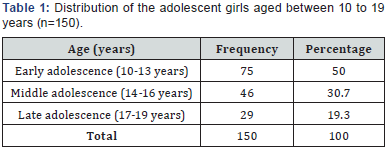
Shows the number of adolescent girls aged between 10 to 19 years. About 50% were aged between 10-13 years, 30.7% were aged between 14-16 years and 19.3 % were aged between 17-19 years.
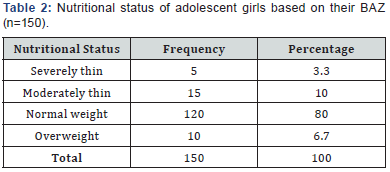
This table shows that about 3.3% of the respondents were severely thin, 10% were moderately thin, 80% were normal, and 6.7%were overweight.
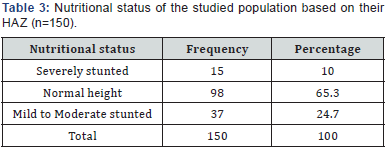
From the above figure, it has been seen that 65.3% of the study population were mild to moderate stunted.

There was a positive correlation between individual BAZ and IDD.
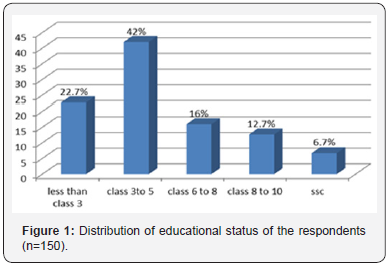
This figure presents that about 22.7% of the girls passed the classes less than class 3, 42% of the girls passed the classes 3 to 5, 16% of the girls passed the classes 6 to 8, 12.7% of the girls passed classes 8 to 10 and 6.7% girls passed SSC.
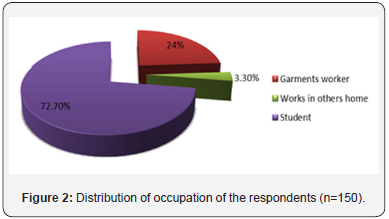
Presents the findings related to the occupation of the respondents. Majority of the respondents (72.7%) were students. 24%of the girls were garments workers and only 3.3% of the girls worked in others’ homes.
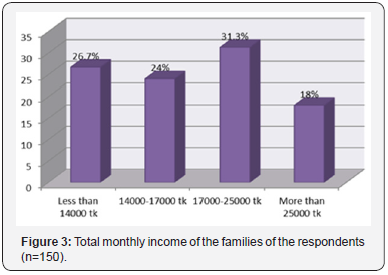
The figure shows that about 31.3% of the families earned between 17000-25000 taka per month.26.7% of the families earned less than 1400 taka, 26.7% families earned between 14000-17000 taka and only 18% families earned more than 25000 taka.
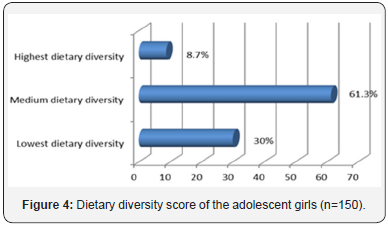
About 61.3% of the adolescent consumed medium dietary diversified food. 30% of the respondent consumed lowest dietary diversified food where 8.7% girls consumed highly diversified food.
Discussion
In order to have a better-earning opportunity poor family from rural areas of our country migrate to cities and begin to live in slum areas. In a tiny period, these poor rural people become accustomed to living in such places and make temporary domicile there. As income earning opportunity is very limited in rural areas, growing number of rural people have migrated and settled temporarily in urban slums in recent years. The slum areas are mostly located by the side of roads and railways, in government khas (free) land and even on platforms erected on water bodies. Adolescence, a period of transition between childhood and adulthood, occupies a crucial position in the life of human beings. The poor nutritional status of adolescent girls has important implications in terms of physical work capacity and adverse reproductive outcomes[13]. Adolescents have specific health and development needs, and many face challenges that hinder their well-being. The findings of this study are kind of similar to some of the previous studies. In this study, the majority of the girls (50%) were in age group 10-13 years (early adolescence), while 30.7% were in age group 14-16 years (middle adolescence) and 19.3% were in the age group 17-19 years (late adolescence). About 24% of the adolescent girls were garments worker. The educational status of the girls was quite satisfactory as the majority of the girls (72.7%) were students. 18% of the family had monthly income more than 25000 takas and 26.7% of the family had monthly income less than 14000 takas. Another study found that 51% of the household of the adolescent had monthly family income more than 20,000 takas and 11.4% had less than 10,000 takas [14]. In this study about 3.3% girls were severely thin, 10% were moderately thin, 80% had normal weight and 6.7% were overweight. The almost similar result was found in a different study, where 9% girls were severely thin,74.7% had normal weight and .3% were obese [7]. Again 10% of the girls were severely stunted and 24% were mild to moderate stunted and 65.3% had normal height. A different study found that the stunted adolescent is 32% [7]. There was a study shows that severe thinness was 9% in rural female adolescent lower than 17% in urban female adolescent found at aged 14-19 years in Bangladesh. The long-term consequences of stunting include deficits in school achievement, reduced work capacity, and adverse pregnancy outcomes [15]. Food security was in lower acceptable range for most of the households (48.7%). About 61.3% of the adolescence girls consumed four to five varieties of food daily. 30% of the girls consume less than 3 food items per day where 8% of the girls consume more than 6 food items per day. The mean dietary diversity score of the adolescent girls was four. A positive relation between individual dietary diversity and nutritional status was also found.Food consumption behavior, nutritional status, and dietary diversity are affected by socio-cultural factors. Poverty, gender, age, geographical location and cultural practices are important factors that affect food consumption pattern and dietary diversity [16]. Food directly influences food consumption due to lack of access to resources, knowledge, and market. Gender disparities in food distribution can cause malnutrition, especially for adolescent girls. Lack of income is the principal driver of low food consumption and malnutrition for about 40% of the Bangladeshi who live under the poverty line[17]. Households most vulnerable to food insecurity include those that lack productive assets and depend on inconsistent sources of daily wage labor. Within households, adolescent girls, children, female members and elderly members face relatively high nutritional risks. The human body requirement is the amount of dietary energy needed to maintain health, growth and an appropriate level of physical activity. A study, conducted in 2008, showed that the mean total food intake of all age and sex of average Bangladeshi population is 681grams. The energy that an individual can derive from this food was 1894. Of the total energy intake, 76% comes from cereal, 17% from noncereal plant sources and 6% from animal sources. Considering the per capita per day energy requirement (2187kcal) and intake (1894 kcal), there is a mean gap of the energy of 293kcal per person. Consumption pattern shows that rice is the dominant energy source, which may lead to malnutrition [18]. Studies have found dietary diversity to be a proxy indicator for nutritional status. Dietary diversity could be affected by intra-household food distribution. Different studies quantify that 1% increase in dietary diversity is associated with 1% rise in per capita consumption[11]. Dietary diversity (DD) has long been recognized by nutritionists as a key element of high-quality diets.Due to unavailability of exact population list, convenience sampling was chosen. Some respondents could not tell about the exact monthly income of their families and some are hesitant to share the information while others concealed. Recall bias may cause over and underestimation of some study variables.
Conclusion
This study concluded that educational status of the adolescent girls in slum areas aged 10-19 was quite satisfactory. Most of the girls (80%) had normal weight but still one third was stunted. A positive correlation between individual dietary diversity and nutritional status were found. From the above study, it can be assumed that community-based adolescentfriendly health and nutrition education and services, and economic development may improve the overall nutritional status of the adolescent girls of the slum area.
References
- Onis MD, Onyango AW, Borghi E, Siyam A, Nishida C, et al. (2007) Development of a WHO growth reference for school-aged children and adolescents. Bull World Health Organ 85(9): 660-667.
- Cappa C, Wardlaw T, Langevin-Falcon C and Diers J (2012) Progress for children: a report card on adolescents. The Lancet 379(9834): 2323- 2325.
- Meier PR, Nickerson HJ, Olson KA, Berg RL, Meyer JA (2003) Prevention of iron deficiency anemia in adolescent and adult pregnancies. Clinical medicine & research 1(1): 29-36.
- Cordeiro LS, Lamstein S, Mahmud Z, Levinson FJ (2006) Adolescent malnutrition in developing countries: a close look at the problem and at two national experiences. SCN news 31: 6-13.
- Story M, Stang J (2005) Nutrition needs of adolescents. Guidelines for adolescent nutrition services. Minneapolis, MN: Centre for Leadership, Education and Training in Maternal and Child Nutrition Division of Epidemiology and Community Health, School of Public Health, University of Minnesota, pp. 21-34.
- Ahmed F, Zareen M, Khan MR, Banu CP, Haq MN, et al. (1998) Dietary pattern, nutrient intake and growth of adolescent school girls in urban Bangladesh. Public Health Nutr 1(2): 83-92.
- Alam N, Roy SK, Ahmed T, Ahmed AS (2010) Nutritional status, dietary intake, and relevant knowledge of adolescent girls in rural Bangladesh. J Health Popul Nutr 28(1): 86-94.
- Viteri FE, Gonzalez H (2002) Adverse outcomes of poor micronutrient status in childhood and adolescence. Nutr Rev 60(5 Pt 2): S77-S83.
- Smith LC, Haddad LJ (2000) Explaining child malnutrition in developing countries: A cross-country analysis. Intl Food Policy Res Inst pp. 1-111.
- Braun B, Abheuer T (2011) Floods in megacity environments: vulnerability and coping strategies of slum dwellers in Dhaka/ Bangladesh. Natural hazards 58(2): 771-787.
- Hoddinott J, Yohannes Y (2002) Dietary diversity as a food security indicator. Food consumption and nutrition division discussion paper 136: 2.
- Kennedy G, Ballard T, Dop MC (2011) Guidelines for measuring household and individual dietary diversity. Food and Agriculture Organization of the United Nations.
- Haboubi GJ, Shaikh RB (2009) A comparison of the nutritional status of adolescents from selected schools of South India and UAE: a crosssectional study. Indian J Community Med 34(2): 108-111.
- Kurshed AAM, Rana MM, Khan S, Azad TA, Begum J et al. (2010) Dietary intake, physical activities and nutritional status of adolescent girls in an urban population of Bangladesh. Ibrahim Med Coll J 4(2): 78-82.
- Akhter N, Sondhya FY (2013) Nutritional status of adolescents in Bangladesh: Comparison of severe thinness status of a low-income family’s adolescents between urban and rural Bangladesh. J Educ Health Promot 2: 27.
- Caswell JA, Yaktine AL (2013) National Research Council. Individual, Household, and Environmental Factors Affecting Food Choices and Access.
- Shil SR (2017) A Study on Life Style and Disease Pattern of Slum Dwellers in Dhaka City (Doctoral dissertation, East West University).
- Murshid KAS (2008) Determination of Food Availability and Consumption Patterns, and Setting Up of Nutritional Standard in Bangladesh. World Food Programme.






























